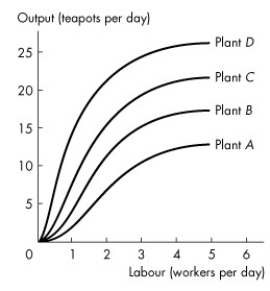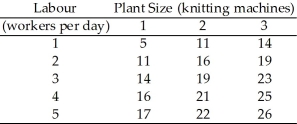A) TFC = TC/Q
B) TFC = TC - AVC
C) TFC = TC - TVC
D) TFC = TVC/Q
E) TFC = TVC - TC
Correct Answer

verified
Correct Answer
verified
Multiple Choice
In the long run, a firm has no factors of production that are
A) variable.
B) marginal.
C) significant.
D) taxable.
E) fixed.
Correct Answer

verified
Correct Answer
verified
Multiple Choice
After constructing a new factory, the cost of building the factor is a
A) past cost.
B) variable cost.
C) significant cost.
D) taxable cost.
E) sunk cost.
Correct Answer

verified
Correct Answer
verified
Multiple Choice
A firm's total product curve describes
A) the minimum cost of producing a given amount of output.
B) the maximum output that a given quantity of labour can produce.
C) how the maximum attainable output varies as the size of the firm's plant varies, given the quantity of labour employed.
D) how the management of the firm makes decisions over the short run.
E) how the amount of labour varies as the amount of output varies.
Correct Answer

verified
Correct Answer
verified
Multiple Choice
Use the figure below to answer the following questions.
 Figure 11.4.1
-Refer to Figure 11.4.1, which illustrates the total product curves for four different plant sizes. One of the fundamental technological facts reflected in the shape of each of the total product curves is the
Figure 11.4.1
-Refer to Figure 11.4.1, which illustrates the total product curves for four different plant sizes. One of the fundamental technological facts reflected in the shape of each of the total product curves is the
A) price of the inputs.
B) price of the output.
C) law of diminishing marginal returns.
D) law of economies of scale.
E) fact that capital and labour cannot be substituted for each other.
Correct Answer

verified
Correct Answer
verified
Multiple Choice
Use the table below to answer the following questions.
Table 11.3.1
 -Refer to Table 11.3.1, which gives Tania's total cost schedule. The average fixed cost of producing 9 teapots per day is
-Refer to Table 11.3.1, which gives Tania's total cost schedule. The average fixed cost of producing 9 teapots per day is
A) $2.22.
B) $1.25.
C) $10.00.
D) $1.11.
E) $1.54.
Correct Answer

verified
Correct Answer
verified
Multiple Choice
Marginal cost ________ as the quantity produced increases.
A) initially decreases and then decreases
B) always decreases
C) always increases
D) initially increases and then decreases
E) becomes negative
Correct Answer

verified
Correct Answer
verified
Multiple Choice
The short run refers to a time period
A) of one year or less.
B) in which all factors of production are variable.
C) in which all factors of production are fixed.
D) in which some factors of production are variable, but at least one factor of production is fixed.
E) in which all factors of production are variable, but the technology is fixed.
Correct Answer

verified
Correct Answer
verified
Multiple Choice
The ATC curve shifts upward if
A) factor prices rise.
B) a new technology is introduced.
C) more workers are hired.
D) all of the above
E) none of the above
Correct Answer

verified
Correct Answer
verified
Multiple Choice
Which of the following factors are fixed in the long run?
A) labour
B) capital
C) land
D) entrepreneurship
E) No factors of production are fixed in the long run.
Correct Answer

verified
Correct Answer
verified
Multiple Choice
Which one of the following statements is false?
A) Average total cost is total cost per unit of output.
B) Average fixed cost plus average variable cost equals average total cost.
C) Marginal cost is the increase in total cost resulting from a one-unit increase in output.
D) Total cost equals fixed cost plus average cost.
E) Marginal cost depends on the amount of labour hired.
Correct Answer

verified
Correct Answer
verified
Multiple Choice
Which one of the following statements is true?
A) The highest value of average product occurs where average product is greater than marginal product.
B) When the average product curve is rising, marginal product is less than average product.
C) When the average product curve is falling, marginal product is greater than average product.
D) The maximum total product occurs at minimum marginal product.
E) The highest value of average product occurs where average product equals marginal product.
Correct Answer

verified
Correct Answer
verified
Multiple Choice
The law of diminishing marginal returns refers to the tendency for the ________ to eventually decrease as more labour is employed, everything else remaining the same.
A) average total cost
B) marginal cost
C) total product
D) marginal product of labour
E) average product of labour
Correct Answer

verified
Correct Answer
verified
Multiple Choice
Use the table below to answer the following questions.
Table 11.4.1
Swanky's output levels
 -Refer to Table 11.4.1, which represents Swanky's production possibilities as the firm varies the quantities of knitting machines and workers per day. If Swanky increases the number of knitting machines from 2 to 3 and increases the number of workers employed from 2 to 3, the factory experiences
-Refer to Table 11.4.1, which represents Swanky's production possibilities as the firm varies the quantities of knitting machines and workers per day. If Swanky increases the number of knitting machines from 2 to 3 and increases the number of workers employed from 2 to 3, the factory experiences
A) economies of scale.
B) constant returns to scale.
C) diseconomies of scale.
D) constant marginal product.
E) minimum efficient scale.
Correct Answer

verified
Correct Answer
verified
Multiple Choice
The average product of labour equals
A) the slope of the total product curve.
B) the slope of the marginal product curve.
C) the increase in total product divided by the increase in labour employed.
D) total product divided by the quantity of labour employed.
E) the difference between the total product and the marginal product of labour.
Correct Answer

verified
Correct Answer
verified
Multiple Choice
When the demand for electricity peaks during the hottest days of summer, Hydro One can generate more electricity by using more fuel and increasing the working hours of many of its employees. The company cannot, however, increase electric power production by building additional generating capacity. This means that the company is operating in the
A) market run.
B) intermediate run.
C) long run.
D) immediate run.
E) short run.
Correct Answer

verified
Correct Answer
verified
Multiple Choice
Marginal product
A) is always negative.
B) equals the slope of the total product curve.
C) is always zero.
D) lies between zero and one.
E) equals average product minus total product.
Correct Answer

verified
Correct Answer
verified
Multiple Choice
One reason for diseconomies of scale is that as output becomes larger and larger,
A) costs per unit decrease.
B) management systems become more efficient.
C) the number of workers increases.
D) management systems can become more complex and inefficient.
E) workers become more efficient.
Correct Answer

verified
Correct Answer
verified
Multiple Choice
Marginal cost is equal to
A) total cost divided by output.
B) the increase in total cost divided by the increase in output.
C) the increase in total cost divided by the increase in labour input, given the amount of capital.
D) total variable cost minus total fixed cost.
E) the increase in total cost divided by the increase in variable cost.
Correct Answer

verified
Correct Answer
verified
Multiple Choice
The steeper the slope of the total product curve,
A) the smaller the average product.
B) the smaller the marginal product.
C) the greater the total cost.
D) the more efficient the technology employed.
E) the greater the marginal product.
Correct Answer

verified
Correct Answer
verified
Showing 101 - 120 of 142
Related Exams